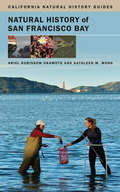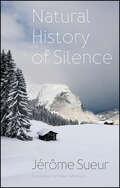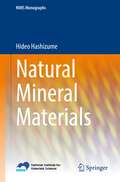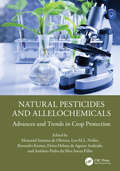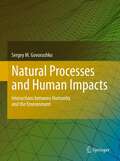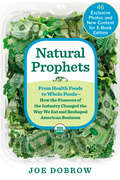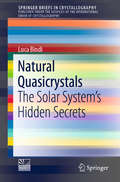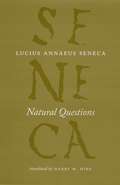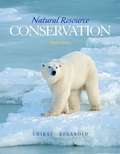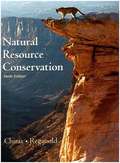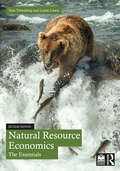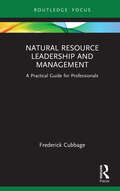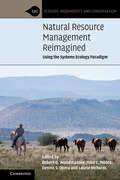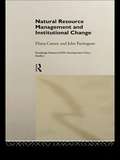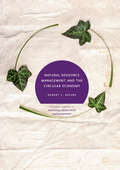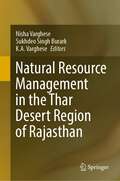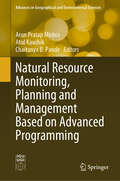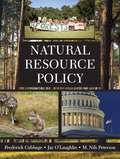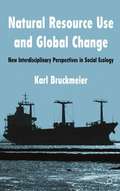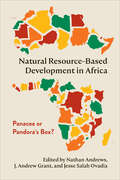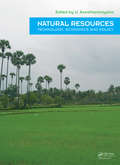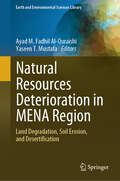- Table View
- List View
Natural History Dioramas
by Sue Dale Tunnicliffe Annette ScheersoiThis book brings together in a unique perspective aspects of natural history dioramas, their history, construction and rationale, interpretation and educational importance, from a number of different countries, from the west coast of the USA, across Europe to China. It describes the journey of dioramas from their inception through development to visions of their future. A complementary journey is that of visitors and their individual sense making and construction of their understanding from their own starting points, often interacting with others (e. g. teachers, peers, parents) as well as media (e. g. labels). Dioramas have been, hitherto, a rather neglected area of museum exhibits but a renaissance is beginning for them and their educational importance in contributing to people's understanding of the natural world. This volume showcases how dioramas can reach a wide audience and increase access to biological knowledge.
Natural History of San Francisco Bay
by Kathleen M. Wong Ariel Rubissow OkamotoThis complete primer on San Francisco Bay is a multifaceted exploration of an extraordinary, and remarkably resilient, body of water. Bustling with oil tankers, laced with pollutants, and crowded with forty-six cities, the bay is still home to healthy eelgrass beds, young Dungeness crabs and sharks, and millions of waterbirds. Written in an entertaining style for a wide audience, Natural History of San Francisco Bay delves into an array of topics including fish and wildlife, ocean and climate cycles, endangered and invasive species, and the path from industrialization to environmental restoration. More than sixty scientists, activists, and resource managers share their views and describe their work--tracing mercury through the aquatic ecosystem, finding ways to convert salt ponds back to tidal wetlands, anticipating the repercussions of climate change, and more. Fully illustrated and packed with stories, quotes, and facts, the guide also tells how San Francisco Bay sparked an environmental movement that now reaches across the country.
Natural History of Silence
by Jérôme SueurIn our busy, noisy world, we may find ourselves longing for silence. But what is silence exactly? Is it the total absence of sound? Or is it the absence of the sound created by humans – the kind of deep stillness you might experience in a remote mountain landscape covered in snow, far away from the bustle of human life? When we listen closely, silence reveals a neglected reality. Neither empty nor singular, silence is instead plentiful and multiple. In this book, eco-acoustic historian Jérôme Sueur allows us to discover a vast landscape of silences which trigger the full gamut of our emotions: anxiety, awe and peace. He takes us from vistas resplendent with full and rich natural silences to the everyday silence of predators as they stalk their prey. To explore silences in animal behaviour and ecology is to discover a counterpoint to the acoustic diversity of the natural world, throwing into sharp relief the grating reverberations of the human activity which threatens it. It is to attune ourselves to a world that our human insensitivities have closed off to us, to take a moment simply to breathe and listen to the place of silence in nature.
Natural Mineral Materials (NIMS Monographs)
by Hideo HashizumeThis book presents natural minerals used as inorganic materials, and inorganic materials exchanging cations or anions in natural minerals for other ions not found in nature. In addition, composites such as natural mineral materials that interact with organic molecules or polymers are introduced according to how they are used.Readers can refer to this volume as a guidebook to search for specific inorganic materials, and, if they wish, can consult any part of it at random. The book will be especially helpful and of interest to both scientists and engineers.
Natural Pesticides and Allelochemicals: Advances and Trends in Crop Protection
by Leo M.L. Nollet Mozaniel Santana de Oliveira Eloisa Helena de Aguiar Andrade Ravendra Kumar Antônio Pedro da Silva Souza FilhoNatural pesticides and allelochemicals are used for protection against invasive plants, but when released into the environment they can have both positive and negative effects on plants. This book discusses a holistic and sustainable approach that balances effective pest management with minimizing environmental impacts, promoting biodiversity, and ensuring food safety and quality. It brings together proposals to help improve the quality of management and production of healthier foods utilizing compounds of natural origin. The authors provide a broad and diverse picture of the applications of terpenoids in plant safety and the possibilities for innovative biotechnological approaches for their extraction.Features: Presents a comprehensive resource on recent advances in natural pesticides and new allelochemicals for crop protection Discusses natural herbicides, sustainable agriculture, and bioeconomic processes Explains the challenges of synthetic pesticides and their costs to human and environmental health Covers different aspects of natural pesticides such as their sources, development, application, and toxicity Helps professionals and scholars involved in chemical technology, biotechnology, and agriculture gain a thorough understanding of crop protection practices tailored to specific crop types, regional conditions, and pest pressure This is a great reference for researchers, academics, students, and professionals involved with or interested in agriculture and the environment, pest control, environmental chemistry, biology, food science, and forest engineering.
Natural Processes and Human Impacts
by Sergey M. GovorushkoThis highly topical book comes at a time when the two-way relationship between humankind and the environment is moving inexorably to the top of the agenda. It covers both sides of this delicate balancing act, explaining how various natural processes influence humanity, including its economic activities and engineering structures, while also illuminating the ways in which human activity puts pressure on the natural environment. Chapters analyze a varied selection of phenomena that directly affect people's lives, from geological processes such as earthquakes and tsunamis to cosmic events such as magnetic storms. The author moves on to consider the effect we have on nature, ranging from the impact of heavy industry to the environmental consequences of sport and recreational pastimes. Complete with maps, photographs and detailed case studies, this book provides a comprehensive overview of the biggest issue we face as a species--the way we relate to the natural world around us. This book includes more than 100 maps showing the global distribution of different natural processes/human activities and more that 450 photographs from many countries and all oceans. It will provide a valuable resource for both graduate students and researchers in many fields of knowledge. Sergey Govorushko is a chief research scholar at the Pacific Geographical Institute, Russian Academy of Sciences. He is also Professor at the Far Eastern Federal University (Vladivostok). Sergey Govorushko received his PhD from the Institute of Geography, Russian Academy of Sciences. His research activities focus on the interaction between humanity and the environment, including the impact of nature on humanity; the impact of humanity on the environment; and assessment of the interaction (environmental impact assessment, environmental audit, etc.). He has authored eight and co-authored seven monographs.
Natural Prophets: From Health Foods to Whole Foods--How the Pioneers of the Industry Changed the W ay We Eat and Reshaped American Business
by Joe DobrowThe e-book edition includes 46 exclusive photos and expanded content!From a handful of idealistic farmers and local co-ops in the 1960s to the domination of juggernauts like Whole Foods, the wild success of the natural and organic foods industry proves that principled business is not just possible, but profitable. With nearly unfettered double-digit annual growth, the development of this now-$88 billion industry is one of the most remarkable untold stories in American business history. Trailblazers like Mo Siegel of Celestial Seasonings, Gary Hirshberg of Stonyfield Farms, and John Mackey of Whole Foods openly challenged the interests of Big American Agribusiness, transformed food manufacturing and retailing, and re-wrote the playbook for small entrepreneurs.Dobrow, a 20-year veteran of the natural foods industry who had a front row seat (and backstage pass) to much of the upheaval and expansion he describes, characterizes the radical vision of these "natural prophets" as one part anti-industrial activism, one part bold opportunism, and one part new-era marketing genius. The triple bottom line—people, planet, profit—emerged as a major new lodestone for successful, values-based business practices.Natural Prophets is a fascinating narrative account of these upstart Davids—their failures and their unprecedented successes—that distills lessons about management, marketing, and entrepreneurial growth, and offers a lively, urgent profile of an industry that continues to change the way we eat, the way we live, and the way we think about ourselves.
Natural Quasicrystals: The Solar System’s Hidden Secrets (SpringerBriefs in Crystallography)
by Luca BindiThis book describes the discovery of quasicrystals (icosahedral and decagonal) in an extraterrestrial rock from the Koryak Mountains of Far Eastern Russia. After a decade-long search for a natural quasicrystal, this discovery opened a new avenue in mineralogy and crystallography that could lead to further discoveries in geoscience, astronomy, condensed matter physics, and materials engineering. For the first time, minerals have been discovered that violate the symmetry restrictions of conventional crystallography. The natural occurrence of such crystals was unexpected, involving previously unknown processes. The fact that the quasicrystals were found in a meteorite formed in the earliest moments of the solar system means these processes have been active for over 4.5 billion years and have influenced the composition of the first objects to condense around the Sun. Finding quasicrystals formed in these extreme environments also informed the longstanding debate concerning the stability and robustness of quasicrystals. Recent shock experiments lend support to the hypothesis that the extraterrestrial quasicrystals formed as a result of hypervelocity impacts between objects in the early Solar system, and that they are probably less rare in the Milky Way.
Natural Questions
by Lucius Annaeus SenecaLucius Annaeus Seneca (4 BCE-65 CE) was a Roman Stoic philosopher, dramatist, statesman, and adviser to the emperor Nero, all during the Silver Age of Latin literature. The Complete Works of Lucius Annaeus Seneca is a fresh and compelling series of new English-language translations of his works in eight accessible volumes. Edited by world-renowned classicists Elizabeth Asmis, Shadi Bartsch, and Martha C. Nussbaum, this engaging collection restores Seneca--whose works have been highly praised by modern authors from Desiderius Erasmus to Ralph Waldo Emerson--to his rightful place among the classical writers most widely studied in the humanities. Written near the end of Seneca’s life, Natural Questions is a work in which Seneca expounds and comments on the natural sciences of his day--rivers and earthquakes, wind and snow, meteors and comets--offering us a valuable look at the ancient scientific mind at work. The modern reader will find fascinating insights into ancient philosophical and scientific approaches to the physical world and also vivid evocations of the grandeur, beauty, and terror of nature.
Natural Resource Conservation: Management For A Sustainable Future
by Daniel Chiras John ReganoldThis comprehensive book describes the ecological principles, policies, and practices required to create a sustainable future. It emphasizes practical, cost-effective, sustainable solutions to these problems that make sense from social, economic, and environmental perspectives. A focus on sustainable development puts readers in touch with one of the most significant shifts in thinking and action in the environmental and resource management arenas. A variety of lasting solutions are provided that make sense from social, economic, and environmental viewpoints.
Natural Resource Conservation: Management For A Sustainable Future
by Daniel D. Chiras John P. ReganoldThis comprehensive text provides the ecological principles, policies, and practices to manage a sustainable future. It emphasizes practical, cost-effective, sustainable solutions to these problems that make sense from social, economic, and environmental perspectives.
Natural Resource Economics: An Introduction
by Barry C. FieldDecisions about the conservation and use of natural resources are made every day by individuals, communities, and nations. The latest edition of Field's acclaimed text highlights the incentives and trade-offs embedded in such decisions, providing a lucid introduction to natural resource issues using the analytical framework of economics.<P><P> Employing a logical structure and easy-to-understand descriptions, Field covers fundamental economic principles and their general application to natural resource use. These principles are further developed in chapters devoted to specific resources. Moreover, this up-to-date volume addresses the challenge of achieving socially beneficial utilization rates in the twenty-first century amid continuing population growth, urbanization, and global climate change.
Natural Resource Economics: The Essentials
by Tom Tietenberg Lynne LewisNatural Resource Economics: The Essentials offers a policy-oriented approach to the increasingly influential field of natural resource economics that is based upon a solid foundation of economic theory and empirical research. Students will not only leave the course with a firm understanding of natural resource economics, but they will also be exposed to a number of case studies showing how underlying economic principles provide the basis for specific natural resource policies. Including current data and research studies, this key text also highlights what insights can be derived from the actual experience. Key features include: Extensive coverage of the major issues including energy, recyclable resources, water policy, land conservation and management, forests, fisheries, other ecosystems, and sustainable development; Introductions to the theory and method of natural resource economics including externalities, experimental and behavioral economics, benefit-cost analysis, and methods for valuing the services provided by the environment; Boxed ‘Examples’ and ‘Debates’ throughout the text which highlight global examples and major points for deeper discussions. The text is fully supported with end-of-chapter summaries, discussion questions, and self-test exercises in the book, as well as with multiple-choice questions, simulations, references, slides, and an instructor’s manual on the Companion Website. This text is adapted from the best-selling Environmental and Natural Resource Economics, 11th edition, by the same authors.
Natural Resource Economics: The Essentials
by Tom Tietenberg Lynne LewisNatural Resource Economics: The Essentials offers a policy-oriented approach to the increasingly influential field of natural resource economics that is based upon a solid foundation of economic theory and empirical research. Students will not only leave the course with a firm understanding of natural resource economics, but they will also be exposed to a number of case studies showing how underlying economic principles provided the foundation for specific natural resource policies. This key text highlights what insights can be derived from the actual experience.Key features include: Extensive coverage of the major issues, including energy, recyclable resources, water policy, land conservation and management, forests, fisheries, other ecosystems, and sustainable development Introductions to the theory and method of natural resource economics, including externalities, experimental and behavioral economics, benefit-cost analysis, and methods for valuing the services provided by the environment Boxed "Examples" and "Debates" throughout the text, which highlight global cases and major talking points. This second edition provides updated data, new studies, and more international examples. There is a considerable amount of new material, with a deeper focus on climate change. The text is fully supported with end-of-chapter summaries, discussion questions, and self-test exercises in the book, as well as a suite of supplementary digital resources, including multiple-choice questions, simulations, references, slides, and an instructor’s manual. It is adapted from the 12th edition of the best-selling Environmental and Natural Resource Economics textbook by the same authors.
Natural Resource Leadership and Management: A Practical Guide for Professionals (Routledge Focus on Environment and Sustainability)
by Frederick CubbageThis book examines leadership and management in natural resources, drawing on literature, principles, and the author’s own experiences as a leader and activist. Developing a general framework summarizing the leadership and management cycle in natural resources for practitioners, the book provides a synthesis of leadership theory and practice stemming from the personal and spiritual values of work, and the key principle of aligning organizational resources and actions with stated intentions. It discusses the somewhat unique context of natural resources, comprised of private and public goods and services and complex societal values. Key strategies that enable natural resource professionals to be leaders at all stages and positions in their career, including vision and sustainability, proficient human resources management, fairness and merit, and transparency and openness are analyzed. Case studies of famous natural resource leaders and activists, including Ding Darling, David Attenborough, Wangari Maathai, Marina de Silva, Greta Thunberg, Bob Brown, and Christina Koch, are included. The book examines their values, training, and principles and how they influenced national or global natural resource management. Drawing on the author’s own experiences as a leader and activist, including his role as Department Head at North Carolina State University, as an elected officer in the Society of American Foresters, and as an activist opposing the sale of the Hofmann Forest, the book provides practical examples and guidelines that professionals can consider and use in their careers. This book will be of great interest to natural resource managers and professionals as well as students studying environmental management and natural resource governance and to practitioners who are looking to develop broader leadership and management skills.
Natural Resource Management Reimagined: Using the Systems Ecology Paradigm (Ecology, Biodiversity and Conservation)
by John C. Moore Robert G. Woodmansee Dennis S. Ojima Laurie RichardsThe Systems Ecology Paradigm (SEP) incorporates humans as integral parts of ecosystems and emphasizes issues that have significant societal relevance such as grazing land, forestland, and agricultural ecosystem management, biodiversity and global change impacts. Accomplishing this societally relevant research requires cutting-edge basic and applied research. This book focuses on environmental and natural resource challenges confronting local to global societies for which the SEP methodology must be utilized for resolution. Key elements of SEP are a holistic perspective of ecological/social systems, systems thinking, and the ecosystem approach applied to real world, complex environmental and natural resource problems. The SEP and ecosystem approaches force scientific emphasis to be placed on collaborations with social scientists and behavioral, learning, and marketing professionals. The SEP has given environmental scientists, decision makers, citizen stakeholders, and land and water managers a powerful set of tools to analyse, integrate knowledge, and propose adoption of solutions to important local to global problems.
Natural Resource Management and Institutional Change (Routledge Research/ODI Development Policy Studies #Vol. 1)
by Diana Carney John FarringtonUsing new evidence from a three year programme of research in developing countries in Asia, Latin America and Africa, the authors describe how government organizations have been privatised, decentralised or restructured while private sector organizations - both non-profit and commercial - have taken on increasingly important roles in resource management and service supply. This book provides an important and easily accessible point of reference for decision-makers and students alike, offering unique view in its breadth of coverage across the natural resources sector and a range of different institutional types and approaches to resource management.
Natural Resource Management and the Circular Economy
by Robert C. BrearsThis book provides insight into how governments are using a variety of innovative fiscal and non-fiscal instruments to develop circular economies with significant economic and environmental benefits. It emphasises the urgent need for these circular economies and to move away from our current, linear model that has led to environmental degradation, volatility of resource prices and supply risks from uneven distribution of natural resources.Natural Resource Management and the Circular Economy illustrates how governments have promoted the development of an economy that can provide substantial net material savings; mitigate price volatility and supply risks; and improve ecosystem health and long-term resilience of the economy. Through a series of case studies, it details the various innovative policy instruments which can be utilised, including regulations; market-based instruments; incentives; research and innovation support; information exchanges; and support for voluntary approaches. The book also proposes a series of best practices for different countries, both developed and developing, who are implementing their circular economy.
Natural Resource Management in the Thar Desert Region of Rajasthan
by Nisha Varghese Sukhdeo Singh Burark K. A. VargheseThis book covers a wide range of issues related to the Thar Desert Region of Rajasthan from an integrated and sustainable development perspective. The chapters in this book cover regional and local issues which are discussed with reference to the past scenario, the present practices, and the future strategies. Some of the issues addressed in this book like arid agroforestry, livelihood, and multidimensional development give it a cutting edge over other related publications currently available in the market. The chapters are supported with relevant pictures which will help the reader to connect with the issues being discussed. This book is useful to students, civil services aspirants, researchers, environmentalists, geographers, and non-professionals who are interested in deserts and desert development.
Natural Resource Monitoring, Planning and Management Based on Advanced Programming (Advances in Geographical and Environmental Sciences)
by Chaitanya B. Pande Arun Pratap Mishra Atul KaushikThis book focuses on cloud-based platforms, advanced programming, machine learning models and programming approaches to assess water and other natural resources, flood impact, land use land cover (LULC), global forest change, global forest canopy height and pantropical nation-level carbon stock, among other areas. Sustainable management of natural resources is urgently needed, given the immense anthropogenic pressure on the environment and the accelerated change in climatic conditions of the earth; therefore, the ability to monitor natural resources precisely and accurately is increasingly important. To meet this demand, new and advanced remote sensing tools and techniques are continually being developed to monitor and manage natural resources effectively. Remote sensing platforms use various sensors to record, measure and monitor even minor variations in the earth's surface features as well as atmospheric constituents. This book shows how environmental and ecological knowledge and satellite-based information can be effectively combined to address a wide array of current natural resource management needs. Each chapter covers the different aspects of a remote sensing approach to effectively monitor natural resources and provide a platform for decision making and policy. The book is a valuable resource for researchers, scientists, NGOs and academicians working on climate change, environmental sciences, agriculture engineering, remote sensing and GIS, natural resources management, hydrology, soil sciences, agricultural microbiology, plant pathology and agronomy.
Natural Resource Policy
by M. Nils Peterson Frederick Cubbage Jay O'LaughlinNatural resource policies provide the foundation for sustainable resource use, management, and protection. Natural Resource Policy blends policy processes, history, institutions, and current events to analyze sustainable development of natural resources. The book's detailed coverage explores the market and political allocation and management of natural resources for human benefits, as well as their contributions for environmental services. Wise natural resource policies that promote sustainable development, not senseless exploitation, promise to improve our quality of life and the environment. Public or private policies may be used to manage natural resources. When private markets are inadequate due to public goods or market failure, many policy options, including regulations, education, incentives, government ownership, and hybrid public/private policy instruments may be crafted by policy makers. Whether a policy is intended to promote intensive management of natural resources to enhance sustained yield or to restore degraded conditions to a more socially desirable state, this comprehensive guide outlines the ways in which natural resource managers can use their technical skills within existing administrative and legal frameworks to implement or influence policy.
Natural Resource Use and Global Change
by Karl BruckmeierBuilding on recent developments in social ecology, this book advances a new critical theory of society and nature, exploring social metabolism and global resource flows in contemporary society. Barriers to global sustainability are identified and conditions for transforming industrial economies towards new sustainable resource use are described.
Natural Resource-Based Development in Africa: Panacea or Pandora’s Box?
by Nathan Andrews J. Andrew Grant Jesse Salah OvadiaThere is no question that Africa is endowed with abundant natural resources of different magnitudes. However, more than a decade of high commodity prices and new hydrocarbon discoveries across the continent has led countless international organizations, donor agencies, and non-governmental organizations to devote considerable attention to the potential of natural resource–based development. Natural Resource–Based Development in Africa places a particular emphasis on the actors that help us understand the extent to which resources could be transformed into broader developmental outcomes. Based on a wide variety of primary sources and fieldwork, including in-person interviews and participant observations, this collection contributes to both scholarly and policy discussions around the governance and economic development roles of local entrepreneurs, transnational firms, civil society groups, local communities, and government agencies in Africa’s natural resource sectors. Natural Resource–Based Development in Africa explores the impact that these actors have on regional trends such as resource nationalism and local procurement policies as well as grassroots-related issues such as poverty, livelihoods, gender equity, development, and human security.
Natural Resources - Technology, Economics & Policy
by U. AswathanarayanaNatural resources management has two principal dimensions : Science-illuminated (earth, space, hydrological, pedological, information, etc. sciences) management of local resources (waters, soils, bioresources, minerals, rocks, sediments, etc.) in an ecologically-sustainable manner, and Value-addition through processing of natural products, through
Natural Resources Deterioration in MENA Region: Land Degradation, Soil Erosion, and Desertification (Earth and Environmental Sciences Library)
by Yaseen T. Mustafa Ayad M. Fadhil Al-QuraishiLand deterioration, drought, desertification, and water resources shrinkage threaten natural resources, negatively impacting environmental, economic, and political stability. The increasing occurrence of climate change (extremes) impacts land degradation processes, soil erosion by water and wind, and salinization. The researchers have invested several years of scientific research in natural resources deterioration, including soil degradation and erosion, land degradation, desertification, and climate changes, which are interesting enough. However, the link between science and policymaking appears to be less active as serious actions do not take fast. The eighteen chapters of this book focus more on topics related to natural resources deterioration, such as land degradation, desertification, drought, climate change, and analysis of numerous case studies. This book presents experts' overviews, study results, experiences, and knowledge of natural resources deterioration in MENA countries. It attracts researchers, experts, scholars, scientists, academics, students, practitioners, graduates, or anybody interested in land degradation, desertification, climate change, and natural hazards that fall within natural resources deterioration. Therefore, researchers keep continuing to do their investigations and produce results that convince stakeholders and policymaking to act immediately towards protecting natural resources and their sustainability.

